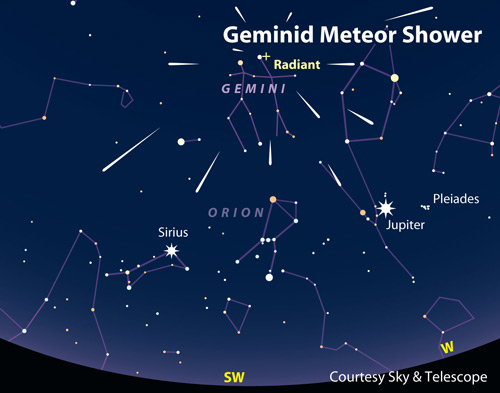If it’s clear late Thursday night, December 13th, 2012, keep a lookout high overhead for the shooting stars of the Geminid meteor shower. The Geminids are usually one of the two best meteor showers of the year, often beating out the Perseids of August. And this year there's no moonlight to interfere.

The Geminids will radiate from the constellation Gemini, shown here nearly overhead as you face southwest around 2 a.m. in the early morning hours of December 14, 2012. For your best view, look wherever the sky is darkest. Click the image for a larger version.
Sky & Telescope
Under a clear, dark sky, you may see at least one Geminid per minute on average from roughly 10 p.m. Thursday until dawn Friday morning. If you live under the artificial skyglow of light pollution your numbers will be less, but the brightest meteors will still shine through.
Lower counts of Geminid meteors should be visible earlier that evening, and a few should also flash into view on the nights of December 11, 12, and 14.
To watch for meteors, you need no equipment but your eyes. Find a dark spot with an open view of the sky and no glary lights nearby. Bundle up as warmly as you can in many layers. Go out late in the evening, lie back, and gaze up into the stars. A reclining lawn chair is a comfortable alternative to lying on the ground. Be patient, and let your eyes adapt to the dark. The best direction to watch is wherever your sky is darkest, probably straight up.
Geminids can appear anywhere in the sky. Small ones appear as tiny, quick streaks. Occasional brighter ones may sail across the heavens for several seconds and leave a brief train of glowing smoke.
If you trace each meteor’s direction of flight backward far enough across the sky, you’ll find that this imaginary line crosses a spot in Gemini near Castor and Pollux. Gemini is in the eastern sky during evening and high overhead in the hours after midnight (for skywatchers at north temperate latitudes). This special spot is called the shower’s radiant. It’s the perspective point from which all the Geminids would appear to come if you could see them approaching from the far distance, rather than just in the last second or so of their lives as they dive into Earth’s upper atmosphere.
Update: On the same dates, a new shower may also be making its appearance. Debris streams from Comet Wirtanen, crossing our orbit for the first time, could produce a couple dozen meteors visible per hour from December 10th to 14th from a radiant just south of the Great Square of Pegasus, according to computer models by Russian meteor scientist Mikhail Maslov. The "Piscids" would be unusually slow moving. Details.
Learn more about meteors and meteor watching.
More on the Geminid Meteoroids
The Geminid meteors are created by tiny bits of rocky debris (the size of large sand grains to pebbles) shed from a small asteroid named 3200 Phaethon. Over the centuries these bits have spread all along the asteroid’s orbit to form a sparse, moving “river of rubble” hundreds of millions of miles long. Earth’s annual orbit around the Sun carries us through this stream of particles every mid-December.
The particles are traveling 22 miles per second (35 km per second) with respect to Earth at the place in space where we encounter them. So when one of them strikes Earth’s upper atmosphere (about 50 to 80 miles up), air friction vaporizes it in a quick, white-hot streak.
More on Light Pollution
Light pollution in the sky doesn’t interfere just with meteor watching. It’s the bane of everyone from backyard nature lovers to professional deep-space researchers. But most light pollution is unnecessary. It results from wasted light beamed uselessly sideways or upwards from all of the poorly designed and improperly aimed outdoor light fixtures for many miles around.
This waste can be prevented by installing modern “full-cutoff shielded” fixtures, or just by aiming fixtures more downward toward the ground where the light is wanted. These simple steps not only reduce light pollution in the sky but allow great savings of electricity. If 100% of a bulb’s light goes where it’s wanted, instead of only 50%, a bulb with half the wattage does the same job.
 0
0
Comments
You must be logged in to post a comment.